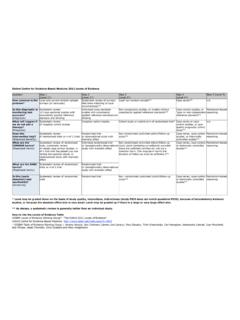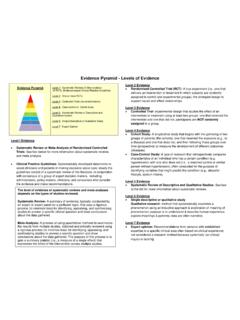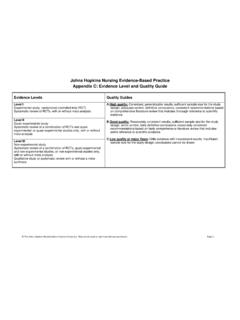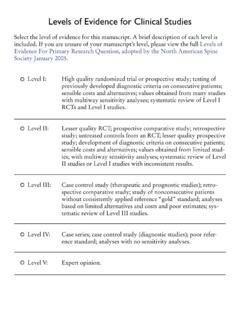Transcription of Levels of Evidence Definitions and Types - CloudCME
1 \\dch comd1\do\ocpd\2018 2019 Activity Files\Traditional Activities Master Files 2018 2019\ Levels of Evidence Definitions and Levels of Evidence What are the Levels of Evidence ? These decisions gives the "grade (or strength) of recommendation." Evidence from a systematic review or meta analysis of all relevant RCTs (randomized controlled trial) or Evidence based clinical practice guidelines based on systematic reviews of RCTs or three or more RCTs of good quality that have similar results. Feb 2, 2017 Levels of Evidence (sometimes called hierarchy of Evidence ) are assigned to studies based on the methodological quality of their design, validity, and applicability to patient care.
2 These decisions gives the "grade (or strength) of recommendation." Level of Evidence (LOE) Description Level I Evidence from a systematic review or meta analysis of all relevant RCTs (randomized controlled trial) or Evidence based clinical practice guidelines based on systematic reviews of RCTs or three or more RCTs of good quality that have similar results. Level II Evidence obtained from at least one well designed RCT ( large multi site RCT). Level III Evidence obtained from well designed controlled trials without randomization ( quasi experimental). Level IV Evidence from well designed case control or cohort studies. Level V Evidence from systematic reviews of descriptive and qualitative studies (meta synthesis).
3 Level VI Evidence from a single descriptive or qualitative study. Level VII Evidence from the opinion of authorities and/or reports of expert committees. This level of effectiveness rating scheme is based on the following: Ackley, B. J., Swan, B. A., Ladwig, G., & Tucker, S. (2008). Evidence based nursing care guidelines: Medical surgical interventions. (p. 7). St. Louis, MO: Mosby Elsevier. \\dch comd1\do\ocpd\2018 2019 Activity Files\Traditional Activities Master Files 2018 2019\ Levels of Evidence Definitions and From the Centre for Evidence Based Medicine, Oxford For the most up to date Levels of Evidence , see Therapy/Prevention/Etiology/Harm: 1a: Systematic reviews (with homogeneity) of randomized controlled trials 1b: Individual randomized controlled trials (with narrow confidence interval) 1c: All or none randomized controlled trials 2a: Systematic reviews (with homogeneity) of cohort studies 2b: Individual cohort study or low quality randomized controlled trials ( <80% follow up) 2c: "Outcomes" Research.
4 Ecological studies 3a: Systematic review (with homogeneity) of case control studies 3b: Individual case control study 4: Case series (and poor quality cohort and case control studies) 5: Expert opinion without explicit critical appraisal, or based on physiology, bench research or "first principles" \\dch comd1\do\ocpd\2018 2019 Activity Files\Traditional Activities Master Files 2018 2019\ Levels of Evidence Definitions and From the Centre for Evidence Based Medicine, Oxford Continued Diagnosis: 1a: Systematic review (with homogeneity) of Level 1 diagnostic studies; or a clinical decision rule with 1b studies from different clinical centers. 1b: Validating cohort study with good reference standards; or clinical decision rule tested within one clinical center 1c: Absolute SpPins And SnNouts (An Absolute SpPin is a diagnostic finding whose Specificity is so high that a Positive result rules in the diagnosis.)
5 An Absolute SnNout is a diagnostic finding whose Sensitivity is so high that a Negative result rules out the diagnosis). 2a: Systematic review (with homogeneity) of Level >2 diagnostic studies 2b: Exploratory cohort study with good reference standards; clinical decision rule after derivation, or validated only on split sample or databases 3a: Systematic review (with homogeneity) of 3b and better studies 3b: Non consecutive study; or without consistently applied reference standards 4: Case control study, poor or non independent reference standard 5: Expert opinion without explicit critical appraisal, or based on physiology, bench research or "first principles" \\dch comd1\do\ocpd\2018 2019 Activity Files\Traditional Activities Master Files 2018 2019\ Levels of Evidence Definitions and From the Centre for Evidence Based Medicine, Oxford Continued Prognosis: 1a: Systematic review (with homogeneity) of inception cohort studies; or a clinical decision rule validated in different populations.
6 1b: Individual inception cohort study with > 80% follow up; or a clinical decision rule validated on a single population 1c: All or none case series 2a: Systematic review (with homogeneity) of either retrospective cohort studies or untreated control groups in randomized controlled trials. 2b: Retrospective cohort study or follow up of untreated control patients in a randomized controlled trial; or derivation of a clinical decision rule or validated on split sample only 2c: "Outcomes" research 4: Case series (and poor quality prognostic cohort studies) 5: Expert opinion without explicit critical appraisal, or based on physiology, bench research or "first principles" Note: A minus sign " " may be added to denote Evidence that fails to provide a conclusive answer because it is either (a) a single result with a wide Confidence Interval; OR (b) a Systematic Review with troublesome heterogeneity.
7 Such Evidence is inconclusive, and therefore can only generate Grade D recommendations. \\dch comd1\do\ocpd\2018 2019 Activity Files\Traditional Activities Master Files 2018 2019\ Levels of Evidence Definitions and Strength of Recommendation Taxonomy (SORT) Code Definition A Consistent, good quality patient oriented Evidence * B Inconsistent or limited quality patient oriented Evidence * C Consensus, disease oriented Evidence *, usual practice, expert opinion, or case series for studies of diagnosis, treatment, prevention, or screening * Patient oriented Evidence measures outcomes that matter to patients: morbidity, mortality, symptom improvement, cost reduction, and quality of life.
8 Disease oriented Evidence measures immediate, physiologic, or surrogate end points that may or may not reflect improvements in patient outcomes ( blood pressure, blood chemistry, physiologic function, pathologic findings). Grading of Recommendations Assessment, Development and Evaluation (GRADE) Code Quality of Evidence Definition A High Further research is very unlikely to change our confidence in the estimate of effect. Several high quality studies with consistent results In special cases: one large, high quality multi centre trial B Moderate Further research is likely to have an important impact on our confidence in the estimate of effect and may change the estimate. One high quality study Several studies with some limitations C Low Further research is very likely to have an important impact on our confidence in the estimate of effect and is likely to change the estimate.
9 One or more studies with severe limitations D Very Low Any estimate of effect is very uncertain. Expert opinion No direct research Evidence One or more studies with very severe limitations Source: GRADE (Grading of Recommendations Assessment, Development and Evaluation) Working Group 2007 1 (modified by the EBM Guidelines Editorial Team) \\dch comd1\do\ocpd\2018 2019 Activity Files\Traditional Activities Master Files 2018 2019\ Levels of Evidence Definitions and Key to Interpretation of Practice Guidelines Agency for Healthcare Research and Quality: A: There is good research based Evidence to support the recommendation. B: There is fair research based Evidence to support the recommendation.
10 C: The recommendation is based on expert opinion and panel consensus. X: There is Evidence of harm from this intervention. USPSTF Guide to Clinical Preventive Services: A: There is good Evidence to support the recommendation that the condition be specifically considered in a periodic health examination. B: There is fair Evidence to support the recommendation that the condition be specifically considered in a periodic health examination. C: There is insufficient Evidence to recommend for or against the inclusion of the condition in a periodic health examination, but recommendations may be made on other grounds. D: There is fair Evidence to support the recommendation that the condition be excluded from consideration in a periodic health examination.







